- Arms of Canada
-
Arms of Her Majesty in Right of Canada 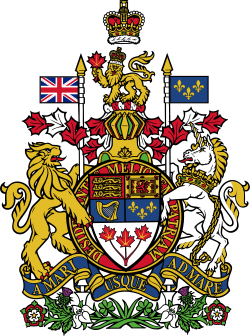
Versions 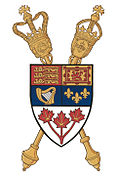
Arms of the Parliament of CanadaDetails Armiger Elizabeth II in Right of Canada Adopted 21 November 1921 Crest Upon a Royal helmet, a lion passant guardant or imperially crowned proper and holding in the dexter paw a maple leaf Gules. Torse Argent and gules, the mantling gules doubled argent. Escutcheon Tierced in fess, the first and second divisions containing the quarterly coat following, namely, 1st Gules three lions passant guardant in pale Or, 2nd, Or a lion rampant within a double tressure flory-counter-flory Gules, 3rd, Azure a harp Or stringed Argent, 4th, Azure three fleurs-de-lis Or, and the third division being Argent three maple leaves conjoined on one stem proper. Supporters Dexter a lion Or holding a lance Argent, point Or, flying therefrom to the dexter the Royal Union Flag, sinister a unicorn Argent armed, crined and unguled Or, gorged with a coronet composed of crosses-patée and fleurs-de-lis a chain affixed thereto and reflexed Or, holding a like lance flying therefrom to the sinister a banner Azure charged with three fleurs-de-lis Or. Compartment A wreath of roses, thistles, shamrocks and lilies proper. Motto A Mari usque ad Mare, Latin for "from sea to sea." Orders The ribbon of the Order of Canada inscribed Desiderantes Meliorem Patriam, Latin for "they desire a better country." Other elements The whole ensigned by the Royal Crown proper. The Arms of Canada (also known as the Royal Coat of Arms of Canada[1][2][3][4][5][6][7][8] or formally as the Arms of His/Her Majesty in Right of Canada)[1][9][10] is, since 1921, the official coat of arms of the Canadian monarch, and thus also of Canada. It is closely modelled after the royal coat of arms of the United Kingdom with distinctive Canadian elements replacing or added to those derived from the British.
The maple leaves in the shield, blazoned "proper", were originally drawn vert (green) but were redrawn gules (red) in 1957. A circlet of the Order of Canada was added to the arms for limited use in 1987. The shield design forms the Royal Standard of Canada, and the shield is found on the Canadian Red Ensign. The Flag of the Governor General of Canada, which formerly used the shield over the Union Flag, now uses the crest of the arms on a blue field.
Contents
History
Prior to Confederation in 1867, the Royal Arms of the United Kingdom served in Canada as the symbol of royal authority.[11] Arms had not been granted to any of the colonies in British North America, apart from the 17th century grants to Nova Scotia[12] and Newfoundland.[13][14] The year after Confederation, arms were granted by Royal Warrant on 6 May to Ontario,[15] Quebec,[16] Nova Scotia[17] (the fact Nova Scotia had been granted arms had been forgotten, and it took until 1929 for the historic arms granted in the 17th Century to be reinstated)[12] and New Brunswick.[18] The warrant did not issue arms to the dominion of Canada, though it made provision for the four provincial arms to be quartered for the purpose of a Great Seal for Canada (though this was never done). A shield of arms first quartered and then, over time, as more provinces and territories joined Canada, marshalled with the arms of the new members of Confederation emerged through popular and even Canadian governmental usage. This eventually resulted in a shield with nine quarterings, an arrangement that had never been approved by the monarch.[11]
Nine quarterings on a shield is too complex[11] for a national symbol, and by 1915 a push had begun to design a new coat of arms for Canada.[19] A committee was formed in 1919 to pursue the issue, eventually agreeing that the elements of the new arms would reference the Royal Arms of England, Ireland, Scotland, and France, with maple leaves representing Canada, though there was at the time no consensus on how the leaves were to be used.[19] The decision was settled by 1920, and the committee consulted with the College of Arms in London, only to face resistance to the use of the Royal Arms from the Garter King of Arms.[19] After some manoeuvring, including the personal intervention of Winston Churchill, the new arms of Canada were eventually formally requested by an Order in Council on 30 April 1921, and adopted in November of the same year by proclamation of King George V as the "Arms or Ensigns Armorial of the Dominion of Canada," on 21 November.[20]
The new layout closely reflected the arms of the United Kingdom,[21] with the addition of maple leaves in the base, and the reference to the French royal arms in the fourth quarter.[22]
In 1931, with the passage of the Statute of Westminster, Canada and other dominions became politically independent from the United Kingdom. This had the effect of elevating the Canadian Coat of Arms which had been granted as deputed arms for particular uses in a colony, to the status of the Royal Arms of the King in right of the country, for general purposes throughout the country. They thus replaced the British Coat of Arms, which had previously been arms of general purpose throughout the British Empire, in court rooms and on government buildings to represent the ruling monarch. This change can be seen in the Great Seal of Canada of George VI where the Royal Arms of Canada have replaced the British Arms, and is made even more evident in the Great Seal of Canada for Elizabeth where the title has been redefined as 'Queen of Canada'.[23] These are the coat of arms of the Queen of Canada.
By 1957, the arms were redrawn by Alan Beddoe so as to have red leaves, and to change the royal crown from one of a Tudor design to one more resembling the St. Edward's Crown, as preferred by Queen Elizabeth II.[11] To mark the 1982 patriation of the Canadian Constitution which finally ended the last vestiges of British authority over Canada, a McGill university student named Bruce Hicks proposed to Secretary of State Gerald Regan that the motto of the Order of Canada should be placed around the shield in order to bring these Royal Arms into line with other Royal Arms, many of which have been displayed in Canada during French, Scottish and English colonisation, where those countries' highest national order of honour appears around the shield of the arms, including the British Royal Arms (which displayed the Order of the Garter), the Scottish Royal Arms (Order of the Thistle) and the Royalist Arms of the French Regime (Order of the Holy Spirit and Order of Saint Michael).[24] While unsuccessful in this first attempt, Bruce Hicks continued his campaign and was joined by a number of other amateur and professional heraldists. As a journalist in the Canadian Parliamentary Press Gallery in Ottawa in the late 1980s and early 90s, Hicks strategically recast the change as something worth doing to commemorate the 25th Anniversary of the Order of Canada (to occur in 1992), an idea that was endorsed by the Advisory Committee on the Order of Canada.[25]
It took until 1994 for the Queen to approve the new design for general use, though the Canadian Heraldic Authority began to allow for its limited use beginning in 1987 where the arms were used to represent Her Majesty personally on letters patent granting new arms for distinguished Canadians.[2] These letters patent carried the shield from the Royal Arms along with the annulus behind the shield bearing the motto of the Order of Canada (Desiderantes meliorem patriam). As soon as Royal approval was forthcoming, the full achievement was redesigned for use by the federal government within the Federal Identity Program.[11]
The government of Canada poster on the Arms of Canada, published by the Department of Canadian Heritage to inform Canadians of the change in 1994, begins with the following acknowledgements: "Based on a suggestion by Mr. Bruce Hicks, of Ottawa, the present design of the Arms of Canada was drawn by Mrs. Cathy Bursey-Sabourin, Fraser Herald at the Canadian Heraldic Authority, Office of the Governor General of Canada, and faithfully depicts the arms described in the words of the Royal Proclamation dated 21 November 1921. It was approved in 1994 and shows a ribbon behind the shield with the motto of the Order of Canada. This version replaces a former design drawn by Mr. Alan Beddoe in 1957.".[26]
In June 2008 MP Pat Martin introduced a motion into the House of Commons calling on the government to amend the coat of arms to incorporate symbols representing Canada's First Nations, Inuit and Métis peoples.[27]
Armorial evolution
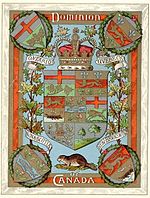
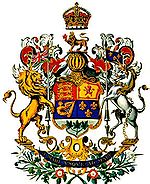
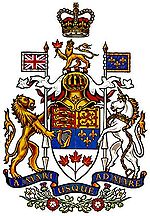
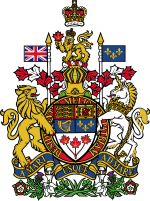
1905 1921 1957 1994 Use
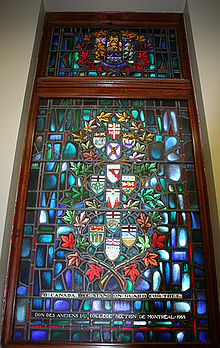 Memorial Stained Glass (1965), Yeo Hall, Royal Military College of Canada featuring Arms of Canada
Memorial Stained Glass (1965), Yeo Hall, Royal Military College of Canada featuring Arms of Canada
The arms are used as a mark of authority by various government agencies and representatives, including the Prime Minister[28] and Cabinet,[29] and most courts, including the Supreme Court.[30] It is also present on all denominations of Canadian paper currency (in fact, the way the Arms are printed on each bill is a security feature),[31] as well as the 50 cent coin,[32] and on the cover of Canadian passports.[33] Since 1962, a banner of the arms, defaced with a variant of the Queen's cypher, has formed the Royal Standard of Canada, for use by the sovereign in her capacity as monarch of Canada.[34] In the Canadian Forces the ranks of Chief Warrant Officer and Chief Petty Officer 1st Class wear the coat of arms as their symbol of rank.[35]
The full achievement of the coat of arms has been used by the Canadian government on occasion on a plain red flag, such as in 1967 for the country's centennial celebrations.[36]
The personal flag of the Governor General has, since 1981, featured the crest of Her Majesty's Royal Arms of Canada on a blue background.[37][38]
In response to a new campaign by Bruce Hicks for the Canadian Parliament to have a distinct heraldic symbol(s) along the lines of the portcullis (variations of which are used by the Commons and Lords in the British Parliament),[39] a proposal that was supported by Speakers of the House of Commons John Fraser and Gilbert Parent, a Commons committee was eventually struck following a motion by MP Derek Lee, before which Hicks and Robert Watt, the first Chief Herald of Canada, were called as the only two expert witnesses, though Senator Serge Joyal joined the committee ex-officio on behalf of the Senate. Commons' Speaker[40] Peter Milliken then asked the Canadian Heraldic Authority to authorize such a symbol and, on 15 February 2008, the Governor General authorized the House of Commons to begin using a badge of the shield of Her Majesty's Royal Arms in right of Canada superimposed on the Ceremonial mace assigned to the House of Commons as a symbol of the Royal authority under which it operates.[41][42] Following the Commons example, the Senate then requested and obtained on 15 April 2008 a similar badge for itself with the shield of Her Majesty's Royal Arms surmounted on the mace assigned to the Senate.[43]
Blazon
The heraldic blazon of Canada's coat of arms is:
Tierced in fesse the first and second divisions containing the quarterly coat following, namely, 1st, gules three lions passant guardant in pale Or, 2nd, Or a lion rampant within a double tressure flory-counter-flory gules, 3rd, azure a harp Or stringed argent, 4th, azure, three fleurs-de-lis Or, and the third division argent three maple leaves conjoined on one stem proper. And upon a royal helmet mantled argent doubled gules the crest, that is to say, on a wreath of the colours argent and gules a lion passant guardant Or imperially crowned proper and holding in the dexter paw a maple leaf gules. And for supporters on the dexter a lion rampant Or holding a lance argent, point Or, flying therefrom to the dexter the Union Flag, and on the sinister a unicorn argent armed crined and unguled Or, gorged with a coronet composed of crosses-patée and fleurs-de-lis a chain affixed thereto reflexed of the last, and holding a like lance flying therefrom to the sinister a banner azure charged with three fleurs-de-lis Or; the whole ensigned with the Imperial Crown proper and below the shield upon a wreath composed of roses, thistles, shamrocks and lillies a scroll azure inscribed with the motto A mari usque ad mare.[20]
The circlet of the Order of Canada was added around the shield for limited use in 1987, and for general use in 1994.[2]
Symbolism
Element Description Image Crown The coat of arms are surmounted by a rendition of St. Edward's Crown, which has been used in the coronations of Canada's monarchs. This element represents Canada's status as a constitutional monarchy headed by a sovereign king or queen.[3] This style of crown is that preferred by Queen Elizabeth II, and was modernized in 1957 from the 1921 design, which used the Tudor crown.[11][19] Crest The crest is based on the Royal Crest of the United Kingdom but differenced by the addition of a maple leaf,[11] and symbolizes the sovereignty of Canada.[44] It appears on the flag of the Governor-General,[44] symbolizing that the Governor General is a representative of the Sovereign. The crest consists of a crowned gold lion standing on a twisted wreath of red and white silk and holding a maple leaf in its right paw. Helm The arms show a royal helmet, which is a barred helm of gold looking outward, with mantling of white and red, stylized in the official version to look like maple leaves.[45] Shield The shield is divided into five sections. The first division at the viewer's top left contains the three golden lions that have been a symbol of England since at least the reign of King Richard I.[46] The second quarter bears the red lion rampant of Scotland in a double tressure border with fleurs-de-lis, used as a symbol of Scotland since at least the reign of William I. The third quarter shows the Irish harp of Tara. The gold fleurs-de-lis of royal France, the first post-medieval European emblem raised in Canada by Jacques Cartier, during his landing at Gaspé,[47] fill the fourth quarter. The fifth charge, a sprig of red maple leaves at the bottom, is a distinctly Canadian symbol that became gradually identified with the country throughout the 19th century.[48] They were first proposed as a symbol in 1834, were established in 1868 on the arms of Quebec and Ontario and officially became the national emblem in 1965, with the proclamation of the Flag of Canada.[45] Initially, the leaves were depicted as coloured green on the coat of arms because it was thought to represent youth, as opposed to the red colour of dying leaves in autumn.[11] However, they are blazoned as "proper," so could be shown as either red or green, and it is the blazon, rather than any depiction, which is regarded as authoritative.[19] The leaves were later redrawn in official depictions in 1957 with the current colour to be in line with the official colours of Canada. They are further stylized in that natural maple leaves do not grow in sprigs of three. The shield forms the basis of the royal standard of Canada.[34]
Ribbon The ribbon is marked desiderantes meliorem patriam, meaning "desiring a better country," which is the motto of the Order of Canada. This component was added by the Queen in 1987 on the advice of her Prime Minister.[2] With the patriation of oversight of arms to Canada through the Canadian Heraldic Authority the following year,[49] the constitution of the Order of Canada was amended to include entitlement by all recipients to encircle their own arms with the ribbon, if arms are granted to them.[50] Since 1994 the arms used by government ministers and institutions have slowly changed to reflect the new version with the ribbon.[11] Motto The motto of Canada is in Latin a mari usque ad mare (From sea to sea), a part of Psalm 72:8.[51] This phrase was suggested by Joseph Pope, then-Under Secretary of State, when the Arms were redesigned in 1921.[21] The motto was originally used in 1906 on the head of the mace of the Legislative Assembly of Saskatchewan.[51] In March 2006, the premiers of Canada's three territories called for the amendment of the motto to better reflect the vast geographic nature of Canada's territory,[52] as Canada has coastlines on the Arctic, Atlantic, and Pacific Oceans. Two suggestions for a new motto are A mari ad mare ad mare (from sea to sea to sea) and A mari usque ad maria (from the sea to the other seas).[53][54]
Supporters Supporting the shield on either side are the English lion and Scottish unicorn, which are also the supporters of the UK coat of arms.[21] The English lion[11] stands on the viewer's left and holds a gold-pointed silver lance flying the Union Flag. The Scottish unicorn[11] has a gold horn, a gold mane, gold hooves, and around its neck a gold, chained coronet of crosses and fleurs-de-lis; it holds a lance flying the three gold fleurs-de-lis of royal France on a blue background.[21] Unlike the British version, the lion is not crowned, nor is it facing the viewer. The broken chain on the unicorn symbolizes the unicorn's resistance to oppression.[11] According to art historian Kenneth Clark, the lion represents ferocity and the unicorn represents lust.[citation needed] According to Robertson Davies in his book The Manticore, the Canadian arms had toned down the genital aspects of the lion and the unicorn, who in previous times had been represented with what Davies called "saucy pizzles."[citation needed] Compartment The entire coat of arms rests on the compartment, which is made up of the floral emblems of the founding countries[11] whose royal arms were incorporated into the design of the shield.[21] The Tudor rose is the floral badge of England (and Wales), combining the White Rose of York and the Red Rose of Lancaster.[21] The thistle and shamrock are the symbols of Scotland and Ireland, respectively, while the fleur-de-lis has been the royal symbol of France since the 12th century.[21][55] Legal
The coat of arms is protected under the Trade-marks Act, which states that "No person shall adopt in connection with a business, as a trade-mark or otherwise, any mark consisting of, or so nearly resembling as to be likely to be mistaken for,... the arms, crest or flag adopted and used at any time by Canada..."[56]
See also
- Flag of Canada
- List of Canadian provincial and territorial symbols
- Great Seal of Canada
- Gallery of country coats of arms
- Royal coat of arms of the United Kingdom
- English claims to the French throne
- New France
- British North America
References
- ^ a b Department of Canadian Heritage (2008). Canada: Symbols of Canada. Ottawa: Queen's Printer for Canada. p. 6. http://www.pch.gc.ca/pgm/ceem-cced/symbl/101/101-eng.pdf. Retrieved 9 September 2009.
- ^ a b c d Parliamentary Debates, Commons, 5 December 1995, columns 1410–1415.
- ^ a b Military Police Complaints Commission. "The Commission > Publications > Outlook With Vision: Annual Report 2001". Queen's Printer for Canada. http://www.mpcc-cppm.gc.ca/300/3000/2001/menu-eng.aspx. Retrieved 28 June 2009.
- ^ Bank of Canada. "Currency Museum > Learning Centre". Queen's Printer for Canada. http://www.bankofcanada.ca/currencymuseum/eng/learning/coins_mapleleaf.php. Retrieved 28 June 2009.
- ^ Reynolds, Ken. Pro Valore: Canada's Victoria Cross (2 ed.). Ottawa: Queen's Printer for Canada. p. 40. http://www.cmp-cpm.forces.gc.ca/dhh-dhp/pub/boo-bro/vc-cv/doc/vc-cv-eng.pdf. Retrieved 31 July 2009.
- ^ Department of National Defence. "Features > 2008 > Modern Canadian Victoria Cross unveiled at Rideau Hall". Queen's Printer for Canada. http://www.forces.gc.ca/site/feature-vedette/2008/05/16-eng.asp. Retrieved 4 August 2009.
- ^ Bousfield, Arthur; Toffoli, Gary (2002). Fifty Years the Queen. Toronto: Dundurn Press. p. 35. ISBN 1-55002-360-8. http://books.google.com/?id=w8l5reK7NjoC&printsec=frontcover&q=.
- ^ Citizenship and Immigration Canada (2009). Discover Canada. Ottawa: Queen's Printer for Canada. pp. 38, 61. ISBN 978-1-100-12739-2. http://www.cic.gc.ca/english/pdf/pub/discover.pdf. Retrieved 3 December 2009.
- ^ "The Coat of Arms of Canada – A Short History". Royal Heraldry Society of Canada. http://www.heraldry.ca/misc/coatArmsCanada.htm. Retrieved 28 June 2009.
- ^ Treasury Board of Canada Secretariat. "Federal Identity Program > Top 10 Policy Guidance Issues". Queen's Printer for Canada. http://www.tbs-sct.gc.ca/fip-pcim/pgi-gop-eng.asp#3. Retrieved 4 February 2011.
- ^ a b c d e f g h i j k l m "Royal Heraldry Society of Canada: The Coat of Arms". RHSC. http://www.heraldry.ca/misc/coatArmsCanada.htm. Retrieved 8 November 2008.
- ^ a b "Canadian Symbols Promotion – Nova Scotia". Canadian Heritage. 21 May 2008. http://www.pch.gc.ca/progs/cpsc-ccsp/atc-ac/ns_e.cfm. Retrieved 21 November 2008.
- ^ "RSNL1990 CHAPTER C-20 – COAT OF ARMS ACT". Earl G. Tucker, Queen's Printer. 2006. http://www.assembly.nl.ca/Legislation/sr/statutes/c20.htm. Retrieved 6 September 2008.
- ^ "Heraldry and Flags: Newfoundland and Labrador Heritage". Memorial University of Newfoundland. http://www.heritage.nf.ca/facts3.html. Retrieved 6 September 2008.
- ^ "Ceremonial and Canadian Symbols Promotion – Ontario". Canadian Heritage. 24 September 2007. http://www.pch.gc.ca/progs/cpsc-ccsp/atc-ac/on_e.cfm. Retrieved 21 November 2008.
- ^ "Ceremonial and Canadian Symbols Promotion – Quebec". Canadian Heritage. 21 May 2008. http://www.pch.gc.ca/progs/cpsc-ccsp/atc-ac/qc_e.cfm. Retrieved 21 November 2008.
- ^ "Nova Scotia/Nouvelle-Ecosse – Coat-of-Arms/Le blason". Government of Nova Scotia. http://www.gov.ns.ca/legislature/HOUSE_OF_ASSEMBLY/Symbols/coat.htm. Retrieved 31 October 2008.
- ^ "Canadian Symbols Promotion – New Brunswick". Canadian Heritage. 24 September 2007. http://www.pch.gc.ca/progs/cpsc-ccsp/atc-ac/nb_e.cfm. Retrieved 21 November 2008.
- ^ a b c d e Fraser, Alistair B (30 January 1998). "Chapter I, Canada's National Symbols". The Flags of Canada. http://fraser.cc/FlagsCan/Nation/NatSym.html. Retrieved 1 October 2008.
- ^ a b "Ceremonial and Canadian Symbols Promotion – The arms of Canada". Canadian Heritage. 23 June 2008. http://www.pch.gc.ca/progs/cpsc-ccsp/sc-cs/arm1_e.cfm. Retrieved 21 November 2008.
- ^ a b c d e f g "Ceremonial and Canadian Symbols Promotion – The arms of Canada (page 2)". Canadian Heritage. 23 June 2008. http://www.pch.gc.ca/progs/cpsc-ccsp/sc-cs/arm2_e.cfm. Retrieved 21 November 2008.
- ^ "Symbols of Canada". Canadian Heritage. 2008. p. 6. http://www.pch.gc.ca/progs/cpsc-ccsp/sc-cs/symboles-histoire-symbols-stories/symbole_canada_symbols-eng.pdf. Retrieved 20 November 2008.
- ^ Swann, Conrad. "Chapter I, Arms of dominion and sovereignty and public authority". Canada Symbols of Sovereignty: An investigation of the arms and seals borne from the earliest times to the present in connection with public authority in and over Canada. along with consideration of some connected flags.
- ^ Hicks, Bruce. The Campaign to Change the Royal Arms of Canada (Hogtown Heraldry 12:4).
- ^ McCreery, Christopher. The Order of Canada: Its Origins, History and Development. ISBN 0802039405.
- ^ Canadian Heritage. The Arms of Canada (Ottawa: Government of Canada).
- ^ "Coat of arms ignores aboriginal people, MP says". CBC News. 20 June 2008. http://www.cbc.ca/canada/manitoba/story/2008/06/20/coat-arms.html. Retrieved 20 June 2008.
- ^ "Prime Minister of Canada / Premier ministre du Canada". Office of the Prime Minister. http://pm.gc.ca/. Retrieved 1 October 2008.
- ^ "Prime Minister of Canada: The Ministry". Office of the Prime Minister. http://pm.gc.ca/eng/cabinet.asp. Retrieved 1 October 2008.
- ^ "Supreme Court of Canada – Welcome Page". Supreme Court of Canada. 4 September 2008. http://www.scc-csc.gc.ca/. Retrieved 1 October 2008.
- ^ "Check to Protect". Bank of Canada / Banque du Canada. http://www.bankofcanada.ca/en/banknotes/education/pdf/91-b-l(01-08)_booklet_en.pdf. Retrieved 1 October 2008.[dead link]
- ^ "Royal Canadian Mint – Monnaie Royale Canadienne". Mint.ca. http://www.mint.ca. Retrieved 21 November 2008.
- ^ "Passport Canada: Features of the Passport". Passport Canada. http://www.pptc.gc.ca/pptc/specifications.aspx?lang=eng. Retrieved 1 October 2008.
- ^ a b Fraser, Alistair B (30 January 1998). "Chapter II, Canada's Head of State". The Flags of Canada. http://fraser.cc/FlagsCan/Nation/StateHead.html. Retrieved 1 October 2008.
- ^ "National Defence and the Canadian Forces". Forces.gc.ca. 30 October 2008. http://www.forces.gc.ca/site/about/Insignia/arma_e.asp. Retrieved 8 November 2008.
- ^ Flags of the World (February 2004). "Canadian Coat of Arms flag". http://flagspot.net/flags/ca_coa.html. Retrieved 14 April 2007.
- ^ "Ceremonial and Canadian Symbols Promotion – Personal Flags and Standards". Minister of Public Works and Government Services. http://www.pch.gc.ca/progs/cpsc-ccsp/sc-cs/o7_e.cfm. Retrieved 4 September 2008.
- ^ "Symbols of the Governor General". Rideau Hall. http://archive.gg.ca/heraldry/emb/index_e.asp. Retrieved 4 September 2008.
- ^ Hicks, Bruce. A ‘Call to Arms’ for the Canadian Parliament" (Canadian Parliamentary Review 23:4).
- ^ "The Speaker – House of Commons Canada – Welcome". Parliament of Canada. http://www.parl.gc.ca/information/about/people/House/Speaker/index_e.html. Retrieved 1 October 2008.
- ^ "Public Register of Arms- House of Commons". Governor General of Canada. http://archive.gg.ca/heraldry/pub-reg/project.asp?lang=e&ProjectID=1246. Retrieved 7 October 2010.
- ^ "Library of Parliament – Canadian symbols at Parliament". http://www2.parl.gc.ca/Sites/LOP/Education/CanSymbols/galleries/parliament/hoc_mace-e.asp. Retrieved 23 August 2010.
- ^ "Public Register of Arms- Senate". Governor General of Canada. http://archive.gg.ca/heraldry/pub-reg/project.asp?lang=e&ProjectID=1283. Retrieved 7 October 2010.
- ^ a b "Symbols of the Governor General". Rideau Hall. http://archive.gg.ca/heraldry/emb/index_e.asp. Retrieved 21 November 2008.
- ^ a b "Ceremonial and Canadian Symbols Promotion – You were asking". Canadian Heritage. 24 September 2007. http://www.pch.gc.ca/PROGS/CPSC-CCSP/sc-cs/df7_e.cfm. Retrieved 21 November 2008.
- ^ "Royal Arms of Britain". Heraldica.org. http://www.heraldica.org/topics/britain/royalarm.htm. Retrieved 21 November 2008.
- ^ "The History of Heraldry in Canada". Royal Heraldry Society of Canada. 28 April 2004. http://www.heraldry.ca/top_en/top_historyHer.htm. Retrieved 21 August 2008.
- ^ "Symbols of Canada". Canadian Heritage. 2008. p. 9. http://www.pch.gc.ca/progs/cpsc-ccsp/sc-cs/symboles-histoire-symbols-stories/symbole_canada_symbols-eng.pdf. Retrieved 20 November 2008.
- ^ "The Canadian Heraldic Authority". Canadian Heraldic Authority. 27 September 2005; updated 14 June 2006. http://archive.gg.ca/heraldry/cha/index_e.asp. Retrieved 2 September 2008.
- ^ "The Constitution of the Order of Canada". Governor General of Canada. 6 December 2005. http://archive.gg.ca/honours/nat-ord/oc/oc-con_e.asp. Retrieved 21 November 2008.
- ^ a b Lamb, W. Kaye. "A Mari usque ad Mare". The Canadian Encyclopedia. Historica Foundation of Canada. http://www.thecanadianencyclopedia.com/index.cfm?PgNm=TCE&Params=A1ARTA0000001. Retrieved 21 November 2008.
- ^ Andrew Chung (28 October 2007). "Time to herald our northern coast?". The Star (Toronto). http://www.thestar.com/News/Ideas/article/271165. Retrieved 21 November 2008.
- ^ Deveau, Scott (3 September 2006). "From sea to sea to sea". Theglobeandmail.com. http://www.theglobeandmail.com/servlet/story/RTGAM.20060309.wmotto0309/BNStory/National/home. Retrieved 21 November 2008.
- ^ CBC News (10 March 2006). "'To sea' or not 'to sea': that is the question". Cbc.ca. http://www.cbc.ca/canada/story/2006/03/10/northern-motto060310.html. Retrieved 21 November 2008.
- ^ Lewis, Philippa; Darley, Gillian (1986). Dictionary of Ornament. Pantheon. ISBN 0394509315. OCLC 978-0394509310.
- ^ Trade-marks Act, R.S.C. 1985, chap. T-13, section 9, sub. 1(e) (Trade-marks Act at Department of Justice Canada)
External links
- The Coat of arms of Canada
- The arms of Canada (Canadian Heritage)
- Royal Heraldry Society of Canada: Coat of Arms of Canada
 Heraldry in Canada
Heraldry in CanadaOrganizations National arms Arms of Canada · Flag of CanadaProvincial and
territorial armsMunicipal arms
of capital citiesOttawa · Charlottetown · Edmonton · Fredericton · Halifax · Iqaluit · Quebec City · Regina · St. John's · Toronto · Victoria · Whitehorse · Winnipeg · Yellowknife · MoreRelated Sovereign states Antigua and Barbuda · Bahamas · Barbados · Belize · Canada · Costa Rica · Cuba · Dominica · Dominican Republic · El Salvador · Grenada · Guatemala · Haiti · Honduras · Jamaica · Mexico · Nicaragua · Panama · Saint Kitts and Nevis · Saint Lucia · Saint Vincent and the Grenadines · Trinidad and Tobago · United States
Dependencies and
other territoriesAnguilla · Aruba · Bermuda · Bonaire · British Virgin Islands · Cayman Islands · Curaçao · Greenland · Guadeloupe · Martinique · Montserrat · Navassa Island · Puerto Rico · Saint Barthélemy · Saint Martin · Saint Pierre and Miquelon · Saba · Sint Eustatius · Sint Maarten · Turks and Caicos Islands · United States Virgin Islands
Heraldry  Canadian royal symbolsRoyal Arms of Canada · Royal standard (Prince of Wales, Duke of Cambridge) · Great Seal of Canada · St. Edward's Crown · Royal cypher · Postage stamps: Victoria, Edward VII, Edward VIII, George VI, Elizabeth II · Royal anthem · Loyal toast · Victoria Day · Accession Day · Jubilees: Golden Jubilee of Victoria, Diamond Jubilee of Victoria · Silver Jubilee of Elizabeth II, Golden Jubilee of Elizabeth II, Diamond Jubilee of Elizabeth II · Royal monuments · Royal eponyms · Royal prefix · Royal patronage · Royal Swans
Canadian royal symbolsRoyal Arms of Canada · Royal standard (Prince of Wales, Duke of Cambridge) · Great Seal of Canada · St. Edward's Crown · Royal cypher · Postage stamps: Victoria, Edward VII, Edward VIII, George VI, Elizabeth II · Royal anthem · Loyal toast · Victoria Day · Accession Day · Jubilees: Golden Jubilee of Victoria, Diamond Jubilee of Victoria · Silver Jubilee of Elizabeth II, Golden Jubilee of Elizabeth II, Diamond Jubilee of Elizabeth II · Royal monuments · Royal eponyms · Royal prefix · Royal patronage · Royal Swans Canadian monarchy
Canadian monarchyThe Crown Viceroys Constitutional Queen-in-Council · Queen-in-Parliament · Queen-on-the-Bench · Queen's peace · The Canadian Crown and the Canadian Forces · The Canadian Crown and Aboriginal peoplesLegal Ceremonial and symbolic Related Categories:- Canadian coats of arms
- National coats of arms
- Monarchy in Canada
- National symbols of Canada
- Canadian heraldry
Wikimedia Foundation. 2010.




